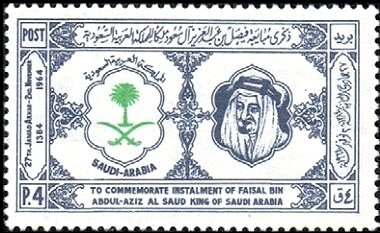Stamp: King Faisal (Saudi Arabia 1964)
King Faisal (Saudi Arabia 1964)
02 November (Saudi Arabia ) within release Installation of Prince Faisal ibn Abdul Aziz as King goes into circulation Stamp King Faisal face value 4 Saudi piastre
| Stamp King Faisal in catalogues | |
|---|---|
| Michel: | Mi:SA 195 |
| Stamp Number: | Sn:SA 285 |
| Yvert et Tellier: | Yt:SA 229 |
Stamp is square format.
Stamp King Faisal it reflects the thematic directions:
King is the title given to a male monarch in a variety of contexts. The female equivalent is queen regnant (while the title of queen on its own usually refers to the consort of a king). In the context of prehistory, antiquity and contemporary indigenous peoples, the title may refer to tribal kingship. Germanic kingship is cognate with Indo-European traditions of tribal rulership (c.f. Indic rājan, Gothic reiks, and Old Irish rí, etc.) In the context of classical antiquity, king may translate Latin rex or either Greek archon or basileus. In classical European feudalism, the title of king as the ruler of a kingdom is understood as the highest rank in the feudal order, potentially subject, at least nominally, only to an emperor (harking back to the client kings of the Roman Empire). In a modern context, the title may refer to the ruler of one of a number of modern monarchies (either absolute or constitutional). The title of king is used alongside other titles for monarchs, in the West prince, emperor, archduke, duke or grand duke, in the Middle East sultan or emir; etc. Kings, like other royalty, tend to wear purple because purple was an expensive color to wear in the past.
A coat of arms is an heraldic visual design on an escutcheon (i.e. shield), surcoat, or tabard. The coat of arms on an escutcheon forms the central element of the full heraldic achievement which in its whole consists of shield, supporters, crest, and motto. A coat of arms is traditionally unique to an individual person, family (except in the United Kingdom), state, organisation or corporation.


